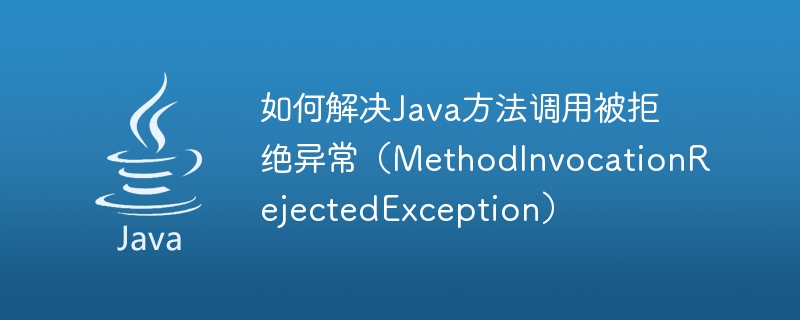

How to solve the Java method invocation rejection exception (MethodInvocationRejectedException)
In the process of using Java development, we often encounter various abnormal situations. Among them, Java method invocation rejected exception (MethodInvocationRejectedException) is a common exception. This article will introduce what the MethodInvocationRejectedException exception is and provide methods and code examples to solve the exception.
What is MethodInvocationRejectedException?
MethodInvocationRejectedException is an exception in the Spring framework. It usually occurs when a method call is rejected. When we use the Spring framework's thread pool or asynchronous tasks, if the thread pool or task queue is full, new method calls will be rejected and a MethodInvocationRejectedException exception will be thrown.
Methods to solve the MethodInvocationRejectedException exception:
The following is a code example using a thread pool to demonstrate how to set up a suitable rejection policy to handle MethodInvocationRejectedException exceptions:
import java.util.concurrent.*; public class ThreadPoolExample { public static void main(String[] args) { // 创建线程池 ThreadPoolExecutor executor = new ThreadPoolExecutor(1, 1, 0L, TimeUnit.MILLISECONDS, new LinkedBlockingQueue<>(1)); // 设置拒绝策略为CallerRunsPolicy executor.setRejectedExecutionHandler(new ThreadPoolExecutor.CallerRunsPolicy()); // 提交任务 for (int i = 0; i < 3; i++) { final int taskId = i; executor.submit(() -> { System.out.println("Task " + taskId + " is running on thread " + Thread.currentThread().getName()); // 模拟任务执行时间 try { Thread.sleep(1000); } catch (InterruptedException e) { e.printStackTrace(); } }); } // 关闭线程池 executor.shutdown(); } }
In the above code, we create a thread pool executor , and set the maximum number of threads to 1 and the task queue size to 1. When the number of submitted tasks exceeds 1, the thread pool will use the CallerRunsPolicy policy to execute the rejected tasks, that is, the tasks will be handed over to the caller thread for execution.
Through the above methods, we can solve the MethodInvocationRejectedException exception and improve the system's concurrent processing capabilities. However, it should be noted that too many threads and too large task queues may cause excessive system resource consumption. Therefore, when setting thread pool parameters, you need to adjust them according to the actual situation.
Summary:
Java method invocation rejected exception (MethodInvocationRejectedException) is a common exception in the Spring framework, which usually occurs when the thread pool or task queue is full. To resolve this exception, we can increase the capacity of the thread pool or task queue, or use an appropriate rejection policy. In actual use, it needs to be adjusted according to system requirements and avoid excessive use of resources.
We hope that the methods and code examples provided in this article can help readers solve MethodInvocationRejectedException exceptions and make better use of thread pools and asynchronous tasks to improve system performance during the development process.
The above is the detailed content of How to solve Java method invocation rejected exception (MethodInvocationRejectedException). For more information, please follow other related articles on the PHP Chinese website!




